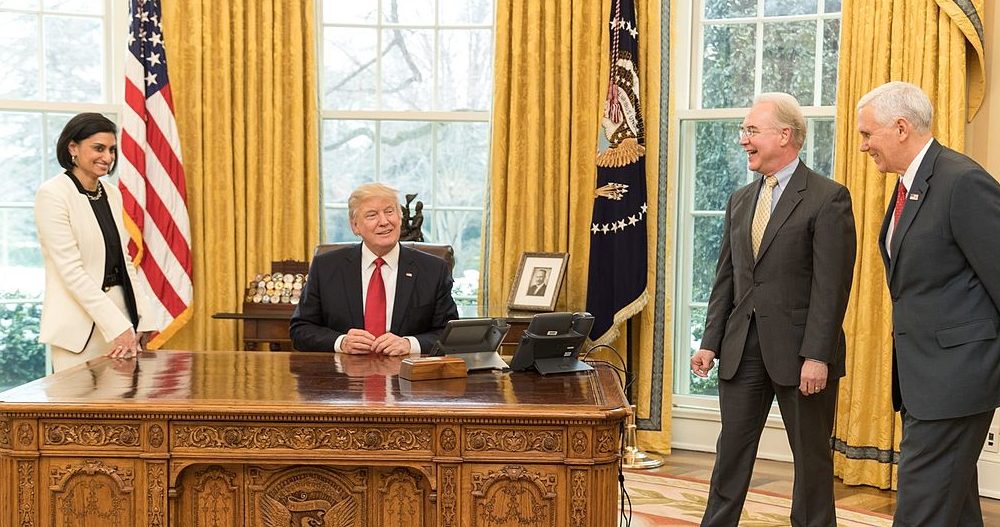Friday, June 30th 2017
Since the first draft of the Senate health care bill was released last week, critics and supporters of the bill have focused attention on how the legislation will impact America’s most vulnerable, particularly the 75 million Americans currently enrolled in Medicaid.
PERMANENT LINK: abc6onyourside.com/news
While the Trump administration and many Republicans support the plan to reform Medicaid and reduce the heavy costs to the federal government, others warn that the plan will jeopardize the state-run health program that now covers a wide array of Americans from the disabled to the working poor and middle-class, from pregnant women, children to the elderly.
The head of the Centers for Medicare and Medicaid Services (CMS) Seema Verma sat down for an interview with Sinclair Broadcast Group national correspondent, Michelle Macaluso last week to discuss the future of Medicaid under the GOP plan.
Take the poll: What action should Congress take on Obamacare?
For the Trump administration, reforming health care is about “choices,” Verma explained, and giving individuals and states greater access to a variety of health care options.
“Just because somebody is poor doesn’t mean that they shouldn’t have choices about their health care coverage,” she said.
“What Obamacare has done is force people to be on the Medicaid program,” Verma said of the changes in Medicaid that led to millions of new enrollees in the government-funded program. “What we’re saying is, we’re going to give people choices, allow them to come to the private market … and pick out the coverage that works well for them.”
If the Senate succeeds in passing its health care plan, it will essential mean the gradual repeal of Medicaid expansion, one of the key factors that allowed the Affordable Care Act (ACA) or Obamacare to insure an additional 20 million people.
Where Obamacare expanded a person’s eligibility for Medicaid and the federal dollars states received for new enrollees, the Republican plan puts a cap on federal Medicaid spending and shifts the responsibility on to the states to determine how they spend that money.
In real terms, the Congressional Budget Office (CBO) estimates that the proposed cap on spending will leave states with $772 fewer dollars for their Medicaid populations by 2026. That would amount to between 14 to 15 million fewer Medicaid recipients.
In an updated report released early this week, the CBO further found that Medicaid spending would drop off by 35 percent within two decades of the proposed law going into effect.
These sharp cuts have been a major cause for concern particularly for the 31 states and Washington D.C. who expanded Medicaid under the ACA.
It’s not clear who the states will cut from their Medicaid rolls, but Verma suggests that it is likely to be the working poor, or those individuals making 138 percent of the federal poverty or $12,000 per year. Those individuals will now be able to purchase insurance.
“We’re just not talking about not covering them,” Verma explained, “but providing coverage through the private market and giving them tax credits and giving them subsidies to help them afford coverage.”
The problem with the tax credits is that they won’t help older and poorer Americans, especially those low-income Americans who are not eligible for Medicaid.
First, the tax credits being offered under the GOP plan would only allow a person to buy a plan that covers 58 percent of their expected medical expenses. Obamacare covered 70 percent.
According to analysis by the non-partisan Kaiser Family Foundation, the tax credits contemplated under the Senate health bill will also mean that poorer and older Americans will end up paying much more than under the ACA, if they even purchase health care.
By 2026, an individual making $11,400 who is not eligible for Medicaid, would pay $300 in premiums with deductibles in excess of $6,000, KFF reports. Low-income seniors can also expect to pay premiums that are nearly three-times as much as they would pay under Obamacare, even with the tax credits.
The Trump administration and Republicans have argued that the GOP plan will be returning the Medicaid program to its rightful place, covering only the most vulnerable people —those in extreme poverty, people with disabilities who can’t work, pregnant mothers and their small children.
“This is about putting a structure in place that will actually improve the program. It’ll put states in charge of the program,” Verma told Sinclair. “It’ll put states in charge of the program, it’ll give them more flexibility to develop innovative programs and actually hold states accountable.
But a number of governors are kicking back against the idea of reclaiming control of the program, especially after receiving substantial Medicaid reimbursements after under President Obama. For years, Medicaid has been the single largest line-item on state budgets, even though they shared the cost with the federal government. Republican and Democratic governors are concerned that shifting Medicaid costs back on to the states will blow out their budgets.
Brian Blase, who now serves as the White House special assistant for healthcare policy, wrote back in 2016 that the Medicaid expansion program was doomed to fail. It was “an unwise policy decision” for the federal government to assume the costs, he said. “The program needed reform, not expansion.”
Overhauling the traditional formula where the cost of Medicaid was more or less equally shared between the federal government and states, Obamacare promised to pay states 100 percent of the cost of new enrollees through 2016, tapering down to 90 percent over the next few years.
What Blase proposed instead was “a fixed amount of federal tax dollars to states combined with real state flexibility to set the rules for their programs,” essentially what is proposed in the Senate health care proposal.
Republican governors, including John Kasich of Ohio and Brian Sandoval of Nevada are also concerned that the cuts in federal funds will mean their states will continue to lose the battle against the heroin and opioid epidemic, with a population that is increasingly unable to access treatment and emergency care.
Others, like Pennsylvania’s Democratic GovernorTom Wolf have expressed concerns that the cuts to Medicaid will cut off funds needed to keep rural hospitals open, and senior citizens in nursing home care, the majority of whom are covered by Medicaid, will also be hurt.
Even Kentucky’s conservative Republican Governor Matt Bevin, who campaigned to repeal Obamacare, applied for a waiver in 2016, requesting the federal government continue to fund 100 percent of the state’s new Medicaid enrollees.
With the federal government offering to match state Medicaid costs 100 percent in the first years of expansion, it was no surprise when costs began to skyrocket.
In 2014, the CBO estimated that the cost of Medicaid expansion over the next year would be $42 billion. It was actually $68 billion. Between 2015 and 2016, the Centers for Medicare and Medicaid Services reported that the cost of medical services for each person receiving coverage through the program had risen by 49 percent.
If the Senate health care bill is enacted as law, it would cap the rate of growth on Medicaid costs and save the federal government hundreds of billions of dollars over the next decade. It would gradually shift more responsibility to the states, but as Verma explained, it would also encourage them to use their federal dollars wisely.
“This bill takes a major step forward with transforming the Medicaid program to put states … in the position of innovating and providing cost-effective care to these people,” Verma explained.
Both the Senate and House bill do have a provision that encourages states to pursue lower-cost, more effective ways to provide for their most vulnerable, as did Obamacare. The ACA allowed states to apply for innovation waivers and opt out of certain provisions as long as it didn’t adversely impact levels of care.
The difference in the GOP formula is it will give states far more leeway to opt out of existing provisions, like providing certain essential health benefits.
Currently, the health care reform bill is stuck in the Senate with at least nine Republicans expressing reservations about how it will impact their constituents. The end results of the GOP efforts to repeal and replace Obamacare are yet to be seen — even by the White House.
The new formula for Medicaid will certainly provide more choices for states and individuals, including the choice to opt out of coverage. And as it is often the case with health care, those choices will be hard choices.






